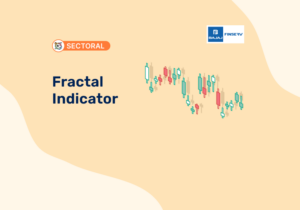Flag Pattern in Trading: Definition & Meaning
Last Updated on December 19, 2023 by BFSLTeam BFSLTeam

One of the most popular and significant chart patterns is the Flag Pattern. It’s a chart pattern that looks like a small rectangle or a channel, visually resembling a flag. These patterns are important because they show a short pause in trading, right before the market continues on its previous path. They are especially useful for understanding the fast-moving Indian stock market. This guide is here to help you learn about these patterns, what they mean, and how they can influence your trading decisions.
Table of Content [hide]
Understanding Flag Pattern
The flag pattern, a crucial factor in technical analysis, is named for its resemblance to a flag on a pole. This pattern signals a continuation of the current trend, either upward or downward. It comprises two main components: the flagpole, which represents a significant price movement, and the flag, a consolidation phase following the initial spike or drop. This pattern is temporary, indicating that the prior trend is likely to continue once the flag formation is complete. Understanding this pattern is crucial as it helps traders predict future stock movements, offering a strategic advantage in the volatile world of stock trading.
Additional Read: What Is a Candlestick Pattern?
Flag Pattern in Trading
As an investor in the Indian market, you’ve likely heard about the flag pattern in trading. This pattern is a key tool in technical analysis, helping you predict future stock movements. It’s similar to spotting a signal in the chaos of market trends. It consists of two parts: the flagpole, a sharp price movement, and the flag, a consolidation phase that follows. It’s a continuation pattern, indicating that the current trend, whether bullish or bearish, is likely to resume after the pattern completes. For you, this means an opportunity to strategize your entry and exit points in the market. Whether you’re dealing with flag pattern stocks or commodities, recognising this pattern can be a game-changer in your trading approach, providing clarity in the vibrant and often unpredictable Indian stock market.
Additional Read: What is Inverted Hammer?
How to Identify Flag Patterns?
Identifying flag patterns involves recognising the flagpole and the flag. The flagpole should be a sharp, linear price movement, while the flag must be a brief consolidation forming a small rectangle or a slight parallel slope against the trend. In Indian markets, where diverse sectors offer varied trends, keeping an eye out for these patterns across different stocks and time frames can be highly beneficial. It’s important to wait for the pattern to fully form and confirm with a breakout or breakdown before making a trade decision.
Additional Read: Morning Star Candlestick Pattern
Bull Flag Pattern
The bull flag pattern is a symbol of optimism in an uptrend. You’ll recognise it by a strong upward movement (the flagpole), followed by a slightly downward or sideways consolidation (the flag). This pattern suggests the bullish momentum is still strong, and the upward trend is likely to continue. For you, as an Indian investor, spotting a bull flag pattern in a thriving sector or stock could signal a buying opportunity. Remember, the key to trading flag patterns successfully is to wait for a clear breakout above the flag. This confirms the continuation and provides a safer entry point. Keep an eye on the volume too; a drop during consolidation and a spike during the breakout can add credibility to the pattern.
Additional Read: Hammer Candlestick Pattern
Bear Flag Pattern
Conversely, the bearish flag pattern signals a continuation of a downtrend. It features a sharp drop in price (the flagpole) and a minor upward or sideways correction (the flag). Spotting a bearish flag pattern in declining sectors or stocks can alert you to potential selling or short-selling opportunities. It’s like a warning signal, suggesting that bearish sentiments are still in play. As a trader in the Indian market, it’s crucial for you to wait for a breakdown below the flag to confirm the continuation of the downtrend. Volume analysis is also essential here; a decrease during the flag formation and an increase at the breakdown can strengthen your confidence in the pattern. Remember, identifying and acting on a bearish flag pattern can be pivotal in safeguarding your investments against potential downturns.
Additional Read: Support and Resistance
Strategies for Trading Flag Patterns
Trading flag patterns can be quite profitable if done correctly. Here are some strategies to consider:
- Wait for the Breakout: It’s crucial to wait for the price to break out of the flag pattern before making a trade. This breakout confirms the continuation of the trend.
- Set Stop-Loss Orders: To minimise risk, setting a stop-loss order just outside the flag pattern can be a wise strategy.
- Consider the Volume: High trading volume during the breakout is a good confirmation of the pattern’s strength.
- Target Price Projection: The flagpole’s length can be used to project the target price post-breakout.
Additional Read: Head and Shoulders Chart Pattern
Conclusion
Understanding the flag pattern, along with its variations like the bull and bear flag patterns, is crucial for successful trading in the Indian stock market. These patterns offer valuable insights into market trends and potential future movements. By identifying and interpreting these patterns correctly, you can make more informed decisions, whether you’re considering it for short-term gains or long-term investments. Remember, while technical analysis is a powerful tool, it should be used in conjunction with other market analyses for the best results.
Disclaimer: Investments in the securities market are subject to market risk, read all related documents carefully before investing.
This content is for educational purposes only. Securities quoted are exemplary and not recommendatory. Click here for RA Disclaimers

